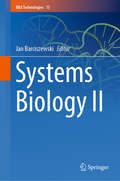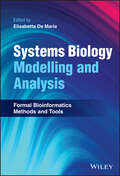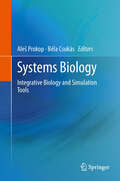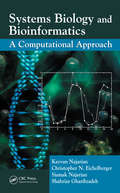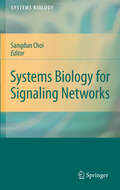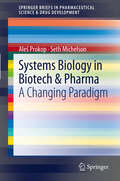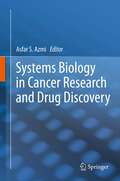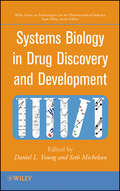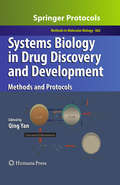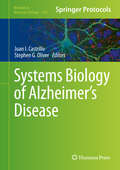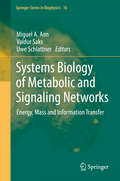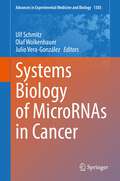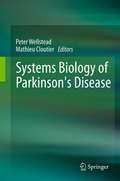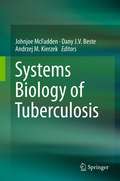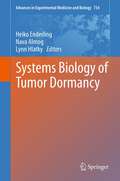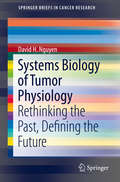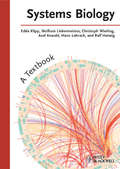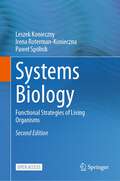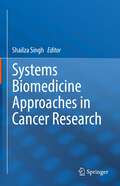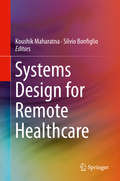- Table View
- List View
Systems Biology II (RNA Technologies #15)
by Jan BarciszewskiModern biology is moving away from reductionist approaches towards holistic studies that encompass whole genomes, transcriptomes, proteomes, and metabolomes. Systems biology is an approach to studying complex biological systems by looking at many biomolecules in a comprehensive way. The aim is to gain a thorough understanding of the biological functions of different classes of molecules and their interactions. Systems Biology II is an up-to-date and comprehensive guide to the latest developments in systems biology, with a particular focus on RNA-based technologies. This book is the second volume in the RNA Technologies series dedicated to this topic. It presents cutting-edge approaches and tools for modelling and analyzing complex biological systems at different levels, from molecular interactions to cellular networks and beyond. With contributions from leading experts in the field, the book covers a wide range of topics, including gene regulatory networks, epigenetics, synthetic biology, omics data analysis, network inference, and more. It explores applications in various areas of the life sciences and biomedicine, such as vaccine development, cancer research, transplantation research and pathogenic processes. This volume is an essential resource for scientists and students working in systems biology, bioinformatics, synthetic biology, and related fields, as well as anyone interested in the latest advances in RNA technologies and their applications in biology and medicine.
Systems Biology Modelling and Analysis: Formal Bioinformatics Methods and Tools
by Elisabetta De MariaSystems Biology Modelling and Analysis Describes important modelling and computational methods for systems biology research to enable practitioners to select and use the most suitable technique Systems Biology Modelling and Analysis provides an overview of state-of-the-art techniques and introduces related tools and practices to formalize models and automate reasoning for systems biology. The authors present and compare the main formal methods used in systems biology for modelling biological networks, including discussion of their advantages, drawbacks, and main applications. Each chapter includes an intuitive presentation of the specific formalism, a brief history of the formalism and of its applications in systems biology, a formal description of the formalism and its variants, at least one realistic case study, some applications of formal techniques to validate and make deep analysis of models encoded with the formalism, and a discussion on the kind of biological systems for which the formalism is suited, along with concrete ideas on its possible evolution. Edited by a highly qualified expert with significant experience in the field, some of the methods and techniques covered in Systems Biology Modelling and Analysis include: Petri nets, an important tool for studying different aspects of biological systems, ranging from simple signaling pathways to metabolic networks and beyond Pathway Logic, a formal, rule-based system and interactive viewer for developing executable models of cellular processes Boolean networks, a mathematical model which has been widely used for decades in the context of biological regulation networks Answer Set Programming (ASP), which has proven to be a strong logic programming paradigm to deal with the inherent complexity of biological models For systems biologists, biochemists, bioinformaticians, molecular biologists, pharmacologists, and computer scientists, Systems Biology Modelling and Analysis is a comprehensive all-in-one resource to understand and harness the field’s current models and techniques while also preparing for their potential developments in coming years with the help of the author’s expert insight.
Systems Biology Volume 1: Integrative Biology and Simulation Tools
by Aleš Prokop Bela CsukasGrowth in the pharmaceutical market has slowed down - almost to a standstill. One reason is that governments and other payers are cutting costs in a faltering world economy. But a more fundamental problem is the failure of major companies to discover, develop and market new drugs. Major drugs losing patent protection or being withdrawn from the market are simply not being replaced by new therapies - the pharmaceutical market model is no longer functioning effectively and most pharmaceutical companies are failing to produce the innovation needed for success. This multi-authored new book looks at a vital strategy which can bring innovation to a market in need of new ideas and new products: Systems Biology (SB). Modeling is a significant task of systems biology. SB aims to develop and use efficient algorithms, data structures, visualization and communication tools to orchestrate the integration of large quantities of biological data with the goal of computer modeling. It involves the use of computer simulations of biological systems, such as the networks of metabolites comprise signal transduction pathways and gene regulatory networks to both analyze and visualize the complex connections of these cellular processes. SB involves a series of operational protocols used for performing research, namely a cycle composed of theoretical, analytic or computational modeling to propose specific testable hypotheses about a biological system, experimental validation, and then using the newly acquired quantitative description of cells or cell processes to refine the computational model or theory.
Systems Biology and Bioinformatics: A Computational Approach
by Kayvan Najarian Siamak Najarian Shahriar Gharibzadeh Christopher N. EichelbergerThe availability of molecular imaging and measurement systems enables today's biologists to swiftly monitor thousands of genes involved in a host of diseases, a critical factor in specialized drug development. Systems Biology and Bioinformatics: A Computational Approach provides students with a comprehensive collection of the computational methods
Systems Biology and Machine Learning Methods in Reproductive Health (Chapman & Hall/CRC Computational Biology Series)
by Dinesh Gupta Abhishek Sengupta Priyanka Narad Deepak ModiSystems Biology and Machine Learning Methods in Reproductive Health is an innovative and wide-ranging book that discovers the synergetic combination of disciplines: systems biology and machine learning, with an application in the field of reproductive health. This book assembles the expertise of leading scientists and clinicians to present a compilation of cutting-edge techniques and case studies utilizing computational methods to elucidate intricate biological systems, elucidate reproductive pathways, and address critical issues in the fields of fertility, pregnancy, and reproductive disorders. Bringing science and data science together, this groundbreaking book provides scientists, clinicians, and students with a step-by-step guide to uncovering the complexities of reproductive health through cutting-edge computational tools.
Systems Biology for Signaling Networks
by Sangdun ChoiSystem Biology encompasses the knowledge from diverse fields such as Molecular Biology, Immunology, Genetics, Computational Biology, Mathematical Biology, etc. not only to address key questions that are not answerable by individual fields alone, but also to help in our understanding of the complexities of biological systems. Whole genome expression studies have provided us the means of studying the expression of thousands of genes under a particular condition and this technique had been widely used to find out the role of key macromolecules that are involved in biological signaling pathways. However, making sense of the underlying complexity is only possible if we interconnect various signaling pathways into human and computer readable network maps. These maps can then be used to classify and study individual components involved in a particular phenomenon. Apart from transcriptomics, several individual gene studies have resulted in adding to our knowledge of key components that are involved in a signaling pathway. It therefore becomes imperative to take into account of these studies also, while constructing our network maps to highlight the interconnectedness of the entire signaling pathways and the role of that particular individual protein in the pathway. This collection of articles will contain a collection of pioneering work done by scientists working in regulatory signaling networks and the use of large scale gene expression and omics data. The distinctive features of this book would be: Act a single source of information to understand the various components of different signaling network (roadmap of biochemical pathways, the nature of a molecule of interest in a particular pathway, etc.), Serve as a platform to highlight the key findings in this highly volatile and evolving field, and Provide answers to various techniques both related to microarray and cell signaling to the readers.
Systems Biology in Biotech & Pharma
by Seth Michelson Aleš ProkopThe US is currently well ahead of the rest of the world in the development and application of SB and its principles especially as they pertain to basic medical research and development. This lead is largely due to its earlier start in the academic arena. However, there is evidence of rapid development in both the UK/EU and Japan, and the gap is narrowing, particularly in the UK. From an industrial point of view, the Pharmaceutical Industry based in the US and UK can capitalize on these opportunities and gain the benefits of this technology. Many educational institutions (particularly their medical divisions) at present are heavily business-oriented, realize that in this particular industrial environment, that every dollar counts.
Systems Biology in Cancer Research and Drug Discovery
by Asfar S AzmiSystems Biology in Cancer Research and Drug Discovery provides a unique collection of chapters, by world-class researchers, describing the use of integrated systems biology and network modeling in the cancer field where traditional tools have failed to deliver expected promise. This book touches four applications/aspects of systems biology (i) in understanding aberrant signaling in cancer (ii) in identifying biomarkers and prognostic markers especially focused on angiogenesis pathways (iii) in unwinding microRNAs complexity and (iv) in anticancer drug discovery and in clinical trial design. This book reviews the state-of-the-art knowledge and touches upon cutting edge newer and improved applications especially in the area of network modeling. It is aimed at an audience ranging from students, academics, basic researcher and clinicians in cancer research. This book is expected to benefit the field of translational cancer medicine by bridging the gap between basic researchers, computational biologists and clinicians who have one ultimate goal and that is to defeat cancer.
Systems Biology in Drug Discovery and Development
by Daniel L. Young Seth MichelsonThe first book to focus on comprehensive systems biology as applied to drug discovery and development Drawing on real-life examples, Systems Biology in Drug Discovery and Development presents practical applications of systems biology to the multiple phases of drug discovery and development. This book explains how the integration of knowledge from multiple sources, and the models that best represent that integration, inform the drug research processes that are most relevant to the pharmaceutical and biotechnology industries. The first book to focus on comprehensive systems biology and its applications in drug discovery and development, it offers comprehensive and multidisciplinary coverage of all phases of discovery and design, including target identification and validation, lead identification and optimization, and clinical trial design and execution, as well as the complementary systems approaches that make these processes more efficient. It also provides models for applying systems biology to pharmacokinetics, pharmacodynamics, and candidate biomarker identification. Introducing and explaining key methods and technical approaches to the use of comprehensive systems biology on drug development, the book addresses the challenges currently facing the pharmaceutical industry. As a result, it is essential reading for pharmaceutical and biotech scientists, pharmacologists, computational modelers, bioinformaticians, and graduate students in systems biology, pharmaceutical science, and other related fields.
Systems Biology in Drug Discovery and Development: Methods and Protocols
by Qing YanDue to the failing "one-drug-fits-all" model, it has become increasingly necessary to develop personalized medicine that treats whole systems and brings the right drug to the right patient with the right dosages. In Systems Biology in Drug Discovery and Development: Methods and Protocols, leading experts provide a practical, state-of-the-art, and holistic view of the translation of systems biology into better drug discovery and personalized medical practice. While the first part of the book describes cutting-edge technologies and methods in the field, the second part illustrates how the technologies can be applied in science for disease understanding and therapeutic discovery. As a volume in the highly successful Methods in Molecular BiologyTM series, this collection provides the kind of detailed description and implementation advice that is crucial for getting optimal results. Authoritative and up-to-date, Systems Biology in Drug Discovery and Development: Methods and Protocols covers topics from fundamental concepts to advanced technologies in order to best serve biomedical students and professionals at all levels who are interested in vital integrative studies in molecular biology, genetics, bioinformatics, bioengineering, biochemistry, physiology, pathology, microbiology, immunology, pharmacology, toxicology, drug discovery, and clinical medicine.
Systems Biology of Alzheimer's Disease
by Juan I. Castrillo Stephen G. OliverAlzheimer's disease (AD) and many other neurodegenerative disorders are multifactorial in nature, involving a combination of genomic, epigenomic, network dynamic and environmental factors. A proper investigation requires new integrative Systems Biology approaches, at both the experimental and computational level. The interplay of disease mechanisms and homeostatic networks will underlie the time of onset and rate of progression of the disease. This book addresses such an integrated approach to AD. It aims to present Systems Biology, including both experimental and computational approaches, as a new strategy for the study of AD and other multifactorial diseases, with the hope that the results will translate into more effective diagnosis and treatment, as well as improved public health policies. Written for the highly successful Methods in Molecular Biology series, practical and cutting-edge, Systems Biology of Alzheimer's Disease is intended for post-graduate students, post-doctoral researchers and experts in different fields with an interest in comprehensive Systems Biology strategies applicable to AD and other complex multifactorial diseases (including other neurodegenerative diseases and cancers). This book aims to complement other excellent volumes and monographs on AD that cover fundamental, physiological or medical aspects of the disease.
Systems Biology of Apoptosis
by Inna N. LavrikSystems Biology of Apoptosis summarizes all current achievements in this emerging field. Apoptosis is a process common to all multicellular organisms. Apoptosis leads to the elimination of cells via a complex but highly defined cellular programme. Defects in the regulation of apoptosis result in serious diseases such as cancer, autoimmunity, AIDS and neurodegeneration. Recently, a substantial step forward in understanding the complex apoptotic pathways has been made by utilising systems biology approaches. Systems biology combines rigorous mathematical modelling with experimental approaches in a closed loop cycle for advancing our knowledge about complex biological processes. In this book, the editor describes the contemporary systems biology studies devoted to apoptotic signaling and focuses on the question how systems biology helps to understand life/death decisions made in the cell and to develop new approaches to rational treatment strategies.
Systems Biology of Cancer
by Sam ThiagalingamWith over 200 types of cancer diagnosed to date, researchers the world over have been forced to rapidly update their understanding of the biology of cancer. In fact, only the study of the basic cellular processes, and how these are altered in cancer cells, can ultimately provide a background for rational therapies. Bringing together the state-of-the-art contributions of international experts, Systems Biology of Cancer proposes an ultimate research goal for the whole scientific community: exploiting systems biology to generate in-depth knowledge based on blueprints that are unique to each type of cancer. Readers are provided with a realistic view of what is known and what is yet to be uncovered on the aberrations in the fundamental biological processes, deregulation of major signaling networks, alterations in major cancers and the strategies for using the scientific knowledge for effective diagnosis, prognosis and drug discovery to improve public health.
Systems Biology of Metabolic and Signaling Networks
by Miguel A. Aon Valdur Saks Uwe SchlattnerSystems Biology represents a new paradigm aiming at a whole-organism-level understanding of biological phenomena, emphasizing interconnections and functional interrelationships rather than component parts. The study of network properties, and how they control and regulate behavior from the cellular to organism level, constitutes a main focus of Systems Biology. This book addresses from a novel perspective a major unsolved biological problem: understanding how a cell works and what goes wrong in pathology. The task undertaken by the authors is in equal parts conceptual and methodological, integrative and analytical, experimental and theoretical, qualitative and quantitative, didactic and comprehensive. Essentially, they unravel the spatio-temporal unfolding of interacting mass-energy and information networks at the cellular and organ levels, as well as its modulation through activation or repression by signaling networks to produce a certain phenotype or (patho)physiological response. Starting with the historical roots, in thirteen chapters this work explores the Systems Biology of signaling networks, cellular structures and fluxes, organ and microorganism functions. In doing so, it establishes the basis of a 21st century approach to biological complexity.
Systems Biology of MicroRNAs in Cancer (Advances in Experimental Medicine and Biology #1385)
by Ulf Schmitz Olaf Wolkenhauer Julio Vera-GonzálezThis book provides an update on the latest development in the field of microRNAs in cancer research with an emphasis on translational research. Since the early 2000s, microRNAs have been recognized as important and ubiquitous regulators of gene expression. Soon it became evident that their deregulation can cause human diseases including cancer. This book focuses on the emerging opportunities for the application of microRNA research in clinical practice. In this context, computer models are presented that can help to identify novel biomarkers, e.g. in circulating microRNAs, and tools that can help to design microRNA-based therapeutic interventions. Other chapters evaluate the role of microRNAs in immunotherapy, immune responses and drug resistance. Covering key topics on microRNAs in cancer research this book is a valuable resource for both emerging and established microRNA researchers who want to explore the potential of microRNAs as therapeutic targets or co-adjuvants in cancer therapies.
Systems Biology of Parkinson's Disease
by Mathieu Cloutier Peter WellsteadThe Systems Biology of Parkinson's Disease will be underpinned by new measurement techniques. This is particularly true of the pathology of Parkinson's Disease, where recent developments in brain imaging have offered new insights into the morphology of dopaminergic neurons that have profound implications for the special vulnerability and role of this class of neurons.
Systems Biology of Tuberculosis
by Dany J.V. Beste Johnjoe Mcfadden Andrzej M. KierzekThe book starts with a general introduction into the relevance of systems biology for understanding tuberculosis. This will be followed by several chapters which describe the application of systems biology to various aspects of the study of the pathogen, Mycobacterium tuberculosis, and its interaction with the host. The book provides the reader with an account of how the new science of systems biology is providing novel insights into the ancient scourge of tuberculosis. It will also describe how systems biology can be applied to the control of tuberculosis, including the development of new treatments, vaccines and diagnostics.
Systems Biology of Tumor Dormancy
by Heiko Enderling Nava Almog Lynn HlatkyThis volume is based on the Workshop on Systems Biology of Tumor Dormancy meeting, held July 25th to July 28th, 2011. The first annual CCSB workshop brought together biologists, clinicians, mathematicians, and computer scientists to discuss various aspects of tumor dormancy and develop novel mathematical/computational models with the keynote speakers. Specific topics included the angiogenic switch, immune system interactions, cancer stem cells and signaling.
Systems Biology of Tumor Physiology
by David H. NguyenThis exciting SpringerBrief presents evidence for new ideas that will challenge several theories of how cancer biology is understood. Cancer biology has undergone several intellectual revolutions in the past 50 years. A mutation-centric view of cancer has given way to the tumor microenvironment view. Reductionistic studies of one gene at a time have given way to systems biology approaches that analyze the whole genome (omics) at the same time. However, this text combines the complex levels studying cancer at the molecular biology level, endocrinology level, and transcriptomics level. What researchers are now realizing is that there is a need to combine omics with physiology concepts in order to better understand cancer and this book will give insight to the merging of these two fields in order to define how cancer is studied in the future.
Systems Biology: A Textbook
by Christoph Wierling Hans Lehrach Axel Kowald Edda Klipp Wolfram Liebermeister Ralf HerwigThis advanced textbook is tailored to the needs of introductory course in Systems Biology. It has a compagnion website (WWW.WILEY-VCH.DE/HOME/SYSTEMSBIOLOGY) with solutions to questions in the book and several additional extensive working models. The book is related to the very successful previous title 'Systems Biology in Practice' and has incorporated the feedback and suggestions from many lecturers worldwide. The book addresses biologists as well as engineers and computer scientists. The interdisciplinary team of acclaimed authors worked closely together to ensure a comprehensive coverage with no overlaps in a homogenous and compelling style.
Systems Biology: Functional Strategies of Living Organisms
by Irena Roterman-Konieczna Leszek Konieczny Paweł SpólnikThis open-access textbook is an excellent introduction to systems biology, which has developed rapidly in recent years. It discusses the processes in living organisms in an integrated way, enabling the reader to understand the fundamental principles and cause-effect relationships in biology and biochemistry. The authors have chosen an original but at the same time clear way of presenting the topics, repeatedly drawing comparisons and models from the macroscopic world and making the reader aware of the unity of the laws of physics, chemistry and biology. The fully updated 2nd edition also contains information that has only become available as a result of the increase in knowledge in recent years. This includes information on tumorigenesis, where significant progress has been made due to the explosive development of genetic knowledge as well as bioengineering with a highly effective technique adopted from the solutions of the bacterial world, such as CRISPR/CAS. This richly illustrated book is essential for postgraduate students and scientists of the following disciplines: biology, biotechnology, medicine, bioinformatics, robotics and automation, biocybernetics, and biomedical engineering. It is also an exciting read for anyone interested in biology.
Systems Biomedicine Approaches in Cancer Research
by Shailza SinghThis book presents the applications of systems biology and synthetic biology in cancer medicine. It highlights the use of computational and mathematical models to decipher the complexity of cancer heterogeneity. The book emphasizes the modeling approaches for predicting behavior of cancer cells, tissues in context of drug response, and angiogenesis. It introduces cell-based therapies for the treatment of various cancers and reviews the role of neural networks for drug response prediction. Further, it examines the system biology approaches for the identification of medicinal plants in cancer drug discovery. It explores the opportunities for metabolic engineering in the realm of cancer research towards development of new cancer therapies based on metabolically derived targets. Lastly, it discusses the applications of data mining techniques in cancer research. This book is an excellent guide for oncologists and researchers who are involved in the latest cancer research.
Systems Consultation and Change in Schools: Integrating Implementation Science into Practice
by Leah M. Nellis Pamela A. FenningThis book explores the ways in which systems (organizational) consultation may be applied to school roles and functions as part of an overall systems change process. Using an implementation science framework grounded in systems/organizational consultation research, the volume details how school reform or improvement may be facilitated. School-based case studies illustrate the application of implementation science to systems change efforts in schools and districts across the United States. Each case study describes the implementation science steps taken to deliver a school-based innovation at the systems level. The book discusses implementation science theory combined with real-world examples of its use in planning for, implementing, and engaging in ongoing evaluation of a systems change effort. Key areas of coverage include:Implementation science in educational settings.Key stakeholder roles in school-based systems change.Implementing and evaluating systems change in schools.Teacher-student mediation to reduce conflict and ensure effective school discipline and behavior practices.District-level processes and supports for English Language Learners.Mental health screening and social-emotional well-being of students. Systems Consultation and Change in Schools is an essential resource for researchers, professors, and graduate students as well as scientist-practitioners, school-based practitioners, and clinicians across such disciplines as school administration and leadership, school and clinical child psychology, social work, public health, teaching and teacher education, educational policy and practice, and all interrelated fields.
Systems Design for Remote Healthcare
by Koushik Maharatna Silvio BonfiglioThis book provides a multidisciplinary overview of the design and implementation of systems for remote patient monitoring and healthcare. Readers are guided step-by-step through the components of such a system and shown how they could be integrated in a coherent framework for deployment in practice. The authors explain planning from subsystem design to complete integration and deployment, given particular application constraints. Readers will benefit from descriptions of the clinical requirements underpinning the entire application scenario, physiological parameter sensing techniques, information processing approaches and overall, application dependent system integration. Each chapter ends with a discussion of practical design challenges and two case studies are included to provide practical examples and design methods for two remote healthcare systems with different needs.
Systems Engineering to Improve Traumatic Brain Injury Care in the Military Health System: Workshop Summary
by Institute of MedicineThis book makes a strong case for taking advantage of the best of two disciplines--health care and operational systems engineering (a combination of science and mathematics to describe, analyze, plan, design, and integrate systems with complex interactions among people, processes, materials, equipment, and facilities)-to improve the efficiency and quality of health care delivery, as well as health care outcomes. Those most interested in pursuing this approach include leaders in the U.S. Department of Defense (DOD) and Department of Veterans Affairs, who are committed to finding ways of improving the quality of care for military personnel, veterans, and their families. Intrigued by the possibilities, DOD decided to sponsor a series of workshops to explore the potential of operational systems engineering principals and tools for military health care, beginning with the diagnosis and care of traumatic brain injury (TBI), one of the most prevalent, difficult and challenging injuries suffered by warriors in Iraq and Afghanistan.
